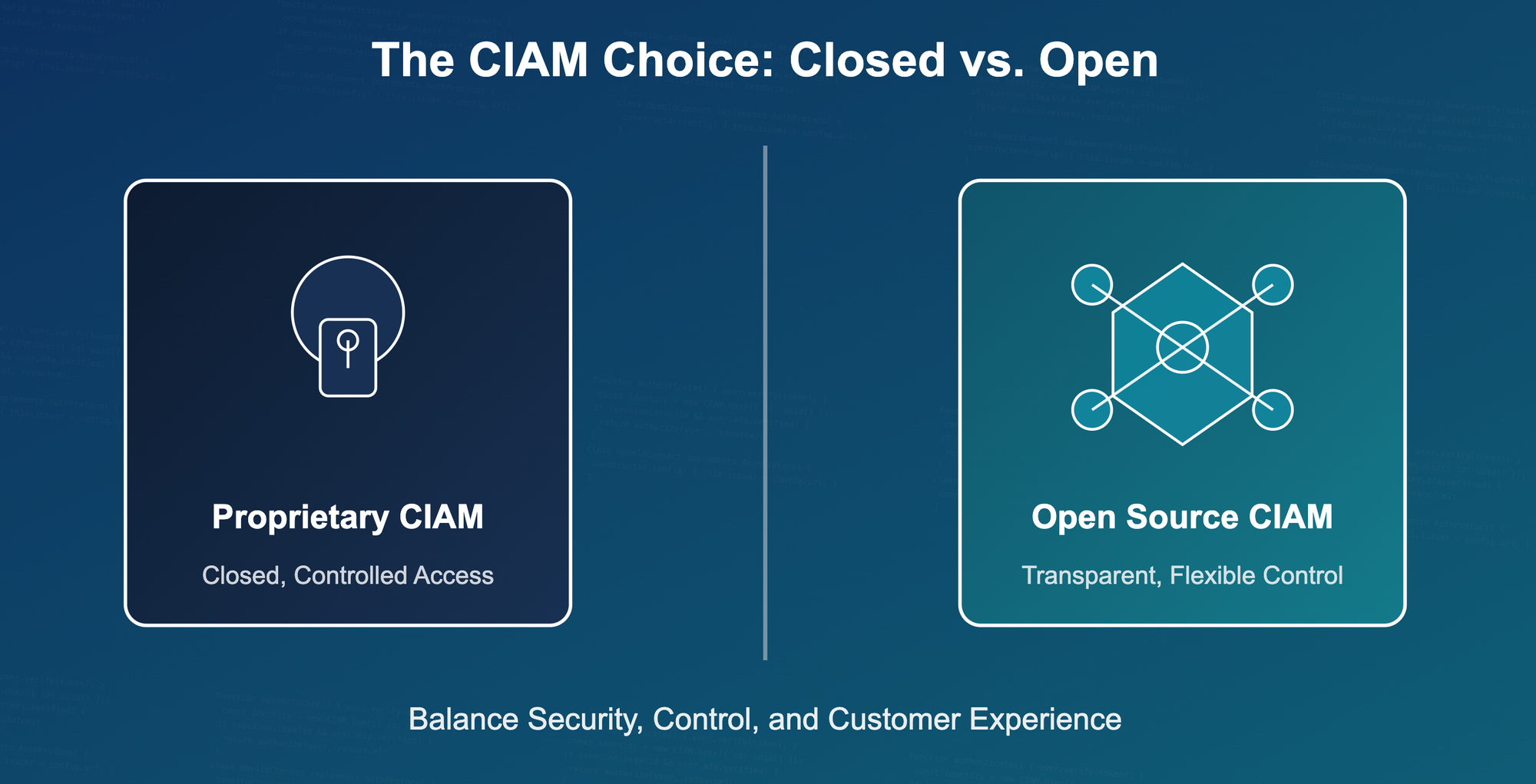Open Source CIAM: A Practical Guide for the Modern Enterprise
Struggling with proprietary identity solutions? This comprehensive guide explores how open source CIAM platforms offer enterprises transparency, flexibility, & cost control while maintaining robust security. Compare leading solutions and discover which best balances security and customer experience.

Introduction: The Case for Open Source Identity Management
Every customer interaction begins with identity in today's digital world. Whether signing into an app, making a purchase, or accessing a service, customers expect seamless yet secure experiences. This is where Customer Identity and Access Management (CIAM) becomes essential.
Think of CIAM as the digital front door to your business—it's what allows your customers to create accounts, sign in securely, manage their profiles, and access your services with minimal friction. But unlike traditional employee-focused identity systems, CIAM must balance robust security with exceptional user experience for potentially millions of customers.
Open source CIAM solutions have emerged as powerful alternatives to proprietary systems, offering organizations greater control, flexibility, and cost-effectiveness. This guide explores the world of open source CIAM, highlighting the leading platforms, their strengths and limitations, and how to choose the right solution for your needs.
What Makes CIAM Different from Traditional Identity Management?
Traditional identity management typically focuses on employees—people you know and can train. CIAM, on the other hand, deals with customers—people you're trying to attract and retain.
The key differences:
- Scale: CIAM must potentially handle millions of users, not hundreds or thousands
- Experience: Customers abandon difficult login experiences; employees usually can't
- Consent: Customer identity requires capturing and managing consent for data usage
- Self-service: Customers need to manage their own profiles and preferences
- Marketing integration: CIAM often connects with marketing tools for personalization
As Curity explains, CIAM is about striking the right balance: "The core principle of CIAM is to provide security without sacrificing user experience." This balance is critical for business success.
Why Consider Open Source for Your CIAM Needs?
Open source CIAM solutions offer compelling advantages over proprietary alternatives:
Transparency and Trust
With open source, the code is available for inspection. This means you can verify exactly how your customers' data is being handled, rather than treating the system as a "black box." Security-conscious organizations appreciate the ability to validate that there are no hidden backdoors or vulnerabilities.
Control Over Your Data
Open source gives you complete control over where and how customer data is stored. This is especially valuable for organizations with strict data sovereignty requirements or those in heavily regulated industries.
Cost-Effectiveness
Most open source CIAM solutions are free to use, with costs primarily related to implementation and operation. This can lead to significant savings compared to proprietary solutions with per-user licensing fees, especially as your customer base grows.
Flexibility and Customization
Every business has unique requirements. Open source solutions can be modified and extended to match your specific needs, integration points, and branding requirements.
Community Innovation
Active open source communities drive continuous improvement through contributions from developers worldwide. This collaborative approach often leads to rapid innovation and quick resolution of security issues.
Of course, these benefits come with certain trade-offs:
Implementation Responsibility
With open source, your team takes on more responsibility for deployment, maintenance, and security. This requires technical expertise that some organizations may need to develop or acquire.
Support Considerations
While community forums can provide valuable assistance, they don't offer the guaranteed response times of commercial support contracts. Some open source projects do offer enterprise support options for organizations that need additional assurance.
Leading Open Source CIAM Platforms
The open source CIAM landscape includes several mature platforms, each with distinct strengths. Let's explore the most widely adopted solutions:
Keycloak: The Enterprise-Ready Solution
Keycloak has emerged as one of the most comprehensive open source identity platforms. Developed by Red Hat and now a Cloud Native Computing Foundation (CNCF) project, Keycloak offers enterprise-grade features in an accessible package.
Key strengths:
- Comprehensive feature set including SSO, social login, and MFA
- Strong integration with enterprise directory services (LDAP, Active Directory)
- Well-documented admin console for centralized management
- Robust clustering support for high availability
- Large and active community with regular updates
"Keycloak's architecture allows for flexible deployment options," notes the Keycloak documentation, "from simple single-server installations to horizontally scalable clusters."
Ory: Cloud-Native Identity for Modern Applications
Ory takes a different approach with its modular, API-first architecture. The platform consists of several components including Ory Kratos (identity management) and Ory Hydra (OAuth2/OpenID Connect).
Key strengths:
- Modern, cloud-native design optimized for Kubernetes environments
- Highly scalable architecture that can handle thousands of instances
- API-first approach ideal for headless implementations
- Flexible "bring your own UI" model for complete frontend control
- Strong focus on security best practices
"Ory is designed for scalable security," the Ory documentation explains, "capable of handling millions of users with flexible authentication and granular permissions."
Authentik: Simplifying Complex Identity Challenges
Authentik aims to make identity management more accessible while still offering powerful capabilities. Its focus on usability makes it particularly appealing for smaller teams.
Key strengths:
- User-friendly interface that simplifies complex identity tasks
- Broad protocol support (SAML, OAuth2, LDAP, RADIUS, and more)
- Application proxy for adding SSO to legacy applications
- Docker-based deployment for simplified operations
- Growing community with an active Discord server
FusionAuth: Developer-Focused Identity
FusionAuth emphasizes developer experience and comprehensive customization options, making it a strong choice for organizations building customer-facing applications.
Key strengths:
- Advanced registration form capabilities for tailored onboarding
- Extensive API and SDK support for easy integration
- Powerful templating system for branding consistency
- Advanced threat detection features
- Comprehensive documentation and developer resources
"FusionAuth is engineered to handle millions of users," according to their documentation, "supporting horizontal scaling to accommodate significant growth."
Comparing Core Capabilities
When evaluating these platforms, several key capabilities should be considered:
| Feature | Keycloak | Ory | Authentik | FusionAuth |
|---|---|---|---|---|
| Authentication Methods | Comprehensive (passwords, social, MFA, passwordless) | Highly configurable with customizable flows | Strong MFA support with flexible options | Rich set of options including WebAuthn/FIDO2 |
| User Management | Full lifecycle management with admin console | API-driven with customizable schemas | Intuitive interface with self-service options | Comprehensive with powerful registration forms |
| Authorization | Role-based and fine-grained policies | Extensible with Keto for complex permissions | Conditional access policies | Flexible permission model |
| Scalability | Good with clustering, may require tuning | Excellent, designed for horizontal scaling | Good for small to medium deployments | Strong horizontal scaling support |
| Customization | Theme-based with extensions | Complete UI freedom with API-first approach | Template-based with configuration options | Comprehensive templating system |
| Community Support | Large, enterprise-focused community | Growing community, strong in cloud-native space | Active Discord community | Engaged forum with commercial support options |
Real-World Use Cases
Open source CIAM solutions shine in various scenarios:
E-commerce Platforms
Online retailers use CIAM to create personalized shopping experiences while securely managing customer data. For instance, an e-commerce site might implement Keycloak to handle user registration, secure checkout, and preference management while integrating with their product recommendation engine.
SaaS Applications
Software-as-a-Service providers implement CIAM to manage user access to different subscription tiers and features. A document collaboration platform might leverage Ory's flexible permission model to control access to shared workspaces based on user roles and tenant relationships.
Mobile Applications
Mobile apps require secure yet frictionless authentication experiences. A fitness tracking app could use FusionAuth's mobile-optimized flows and biometric authentication to provide a seamless login experience while maintaining strong security.
B2B Platforms
Business-to-business applications often need to manage both organizations and their users. A marketing platform might implement Authentik's conditional access policies to allow company administrators to manage their own team members' access levels.
Security Best Practices
Regardless of which platform you choose, following these security practices is essential:
- Enable Multi-Factor Authentication (MFA) - Require or strongly encourage MFA for all accounts, especially administrative ones
- Implement Strong Password Policies - Enforce minimum length and complexity while checking against known breached passwords
- Secure All Communications - Ensure all traffic is encrypted with HTTPS/TLS, including behind your firewall
- Regular Security Audits - Conduct periodic security reviews of your CIAM configuration
- Keep Your Platform Updated - Apply security patches promptly to protect against known vulnerabilities
- Implement Rate Limiting - Protect against brute force and automated attacks with request limits
- Follow the Principle of Least Privilege - Grant only the minimum permissions necessary for each user role
Each platform also has specific security considerations:
- For Keycloak, secure the admin console with strong credentials and restricted network access
- With Ory, configure CSRF protection and implement their security best practices
- For Authentik, consider disabling dangerous expressions in high-security environments
- With FusionAuth, leverage their advanced threat detection features for enhanced protection
The Future of Open Source CIAM
The CIAM landscape continues to evolve, with several trends shaping its future:
Passwordless Authentication
The movement away from passwords toward more secure and user-friendly methods like biometrics, passkeys, and magic links is accelerating. All major platforms are enhancing their support for these technologies.
Decentralized Identity
Self-sovereign identity approaches are gaining traction, giving users more control over their digital identities. This model reduces the need for centralized identity stores and increases privacy.
AI-Enhanced Security and Personalization
Artificial intelligence is being leveraged both for security (detecting anomalous login patterns) and for creating more personalized user experiences based on behavior and preferences.
Privacy-First Approaches
With regulations like GDPR and CCPA becoming more common, CIAM solutions are placing greater emphasis on consent management and data minimization capabilities.
Making Your Decision
Choosing the right open source CIAM solution involves assessing your specific needs:
- Scale Requirements - How many users will you need to support now and in the future?
- Technical Expertise - What is your team's familiarity with the technologies used by each platform?
- Integration Needs - Which systems will need to connect with your CIAM solution?
- Customization Requirements - How important is the ability to tailor the user experience?
- Support Considerations - Will community support be sufficient, or do you need commercial options?
For most enterprise deployments, Keycloak offers the most comprehensive solution with extensive documentation and a large community. Organizations building modern, cloud-native applications may prefer Ory's API-first approach. Smaller teams with simpler requirements might find Authentik's user-friendly interface appealing, while development teams focused on customer experience might lean toward FusionAuth's customization capabilities.
Regardless of which platform you choose, implementing open source CIAM can provide your organization with greater control, flexibility, and cost-effectiveness while delivering secure and seamless experiences for your customers.

